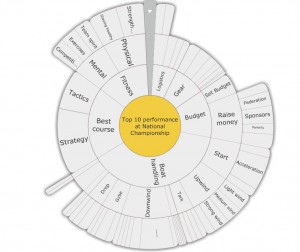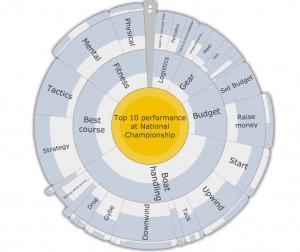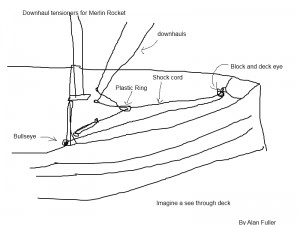Goal Setting – The Professional Approach
Have you set any goals for the coming season? If you have, then well done – you are on the right track. Of all the things that full-time, professional sailors do that the rest of us weekend warriors do not do, structured goal setting is probably the most important. Fortunately it is also one of the less demanding activities (compared to, say, completing 10,000 perfect tacks). With the right approach it can be done quickly – and it can even be fun.
Why goal setting makes a difference
It’s not just about the time and money (and energy!) you have available, it’s how you spend those resources. For example, practising some boathandling exercises might be a better use of a day’s sailing than doing a couple of club races. Or maybe a day’s coaching is a better investment than buying a new jib.
Think about what you want to achieve, then set some specific goals. Goal setting has been shown to be a major factor in improving performance in almost every area of life; yet most of us still do not set any goals, let alone reach them. Maybe we are protecting ourselves: if we do not set goals we cannot fail at them! But that is lazy thinking and it brings only frustration.
So let’s look at setting some sailing goals – and planning how to achieve them.
Mapping out your road to success
Think about your long-term sailing goals. How exactly do you want to improve? What specific goal will motivate you to do everything you need to do to achieve it? Maybe you want to be so fit and skilled that you are ‘at one with your boat’ in all conditions; or maybe you just want to be able to compete in 25 knots without capsizing.
Try to stick to Performance and Process goals: those that depend entirely on your own efforts and abilities. You can set Outcome goals: winning a club series or a championship – or even an Olympic medal. But you have to accept that achieving such goals is not completely within your control.
You want to improve as much as possible with the talent, time and money you bring to the game, so aim high. Describe your goal in inspirational terms and write it down somewhere as your Main Goal. Once you know where you are going, you can start to work out how to get there. What’s most important in the goal-setting process is the journey you take to reach the desired outcome.
You can do quite a lot on paper – as long as you keep it somewhere safe and easily accessible. With decent software though, not only can you define goals and plans, you can also track your progress dynamically and adapt quickly. I like Goalscape (www.goalscape.com) because it can capture an entire campaign in a single picture (as shown in the screenshots that accompany this article) – and because it’s really easy to use.
Lots of sailors in Olympic classes use this tool, but in fact it can help anyone who is serious about improving their skills – and results.
Next year’s results depend on what you do right now
The best way to plan your route to your main goal is to break down your sailing into different areas and work out exactly what you need to do in each.
The fundamental ‘building blocks’ are always the same, whatever your current abilities and whatever your goals. In the diagram below these are the top-level subgoals around the main goal in the centre. (The size of each subgoal’s slice represents its relative importance.)
Three of these goals are about arriving at the starting line in the best possible shape:
• Logistics (planning the year: training, events, travel and accommodation, etc)
• Gear (hull, rig, sails, foils, fittings, clothing, etc)
• Budget (money available for equipment, events etc)
These goals are all about preparation. You can start thinking right now about what you need to do and how to do it.
The other three are about the abilities you need when racing:
• Boat handling (executing every skill in all conditions)
• Finding the best course (strategy and tactics)
• Fitness (mental skills, physical strength, balance, etc)
These are the core goals for maximising your performance on the water.
Define specific goals in each area and plan exactly how you are going to achieve them. Break down each subgoal area into further subgoals:
Keep breaking down the subgoals even further until you have defined specific actions to achieve them all. Below is a detail view of the ‘Boat handling’ area, showing the key aspects of boathandling that you need to master in order to race properly and the specific manoeuvres involved. (Can you guess what the ‘hidden’ one at 11 o’clock is?)
The full structure shown below is suitable for Olympic athletes and club sailors alike ( from time to time GoalScape make available these goal maps for sailors and other activities when you purchase their software, contact them for details of what currently they will offer for free).
You can adapt this framework to reflect your personal goals and circumstances – and to suit class-specific requirements. You might want to change the importance you assign to each goal, delete some lower level goals or even add some new ones of your own.
Focus your efforts
When you first do a proper goal setting exercise, it can be exciting when you see all the different areas where you can improve. It can also be overwhelming! A common mistake here is to go from doing nothing to trying to do too much all at once.
A good way to start is to identify a maximum of three areas that offer the greatest opportunity for improving your performance. How do you do that? One way is to think back through your last season, or even your last race. Be honest: what did you do well and what let you down? Where could you make the greatest improvements in the shortest time? If you capsized a lot when tacking in strong winds for example, you have an easy answer.
So if you can come up with three ideas for tacking more safely, then you can write them into your tacking process breakdown as subgoals:
1. Ease sails sooner before the tack
2. Steer more slowly through the tack
3. Move more quickly up to the new windward side
Work out some good ways to practise and how to measure your progress. If you train in a pair or a group, watch what the others do. Ask them to watch you and give you some specific feedback.
On the other hand if your boat handling is good but your race strategy is poor, look at your information-gathering and decision-making processes.
Find out how other people do all this: talk to some of the good guys – or visit a sailing forum. On Andy Rice’s www.SailJuice.com, anyone can ask a question: an expert contributor or another member will answer it; or Andy will ask some top sailors for their views.
Debrief thoroughly after each practice or competition. Be positive: agree where you have improved and how much. Update your written plan – seeing your progress advancing increases your motivation – and highlights what you need to prioritise next.
The chart below shows a team’s progress (darker shading) with a month to go before their nationals.
These guys need to keep practising their boat handling, especially in strong winds. They also need to do some serious work on their starting process and slow sailing skills. Better starts will help their first beats as well!
If you identify specific problems in every area and find three possible solutions for each of them (or just one!), you are already doing better than 95% of your opposition.
Stick at it!
Persist with this process of gradual, incremental improvements in the key areas of your game and your weaknesses will start to disappear. You may find that your old failings become your new strengths: each is a separate proof of the effectiveness of your process.
Soon you will enjoy doing the very things that you used to hate or fear. If you were nervous in strong winds you will be more competent and more confident: you will love racing in a breeze when you can stay upright while your rivals are falling over.
Double Olympic Champion Iain Percy once said: “I enjoy the process of improvement almost more than the winning itself. That’s where the real satisfaction comes. Identify your weaknesses, set goals, practise until you get better – and the results will look after themselves.”
So start setting some goals for your sailing right now. It is the single activity most likely to improve your performance and results, so there is simply no excuse not to do it. And don’t stop, even if you reach your goals – in fact especially if you reach your goals. Instead, set yourself new goals in every area – and start working on them immediately.
Richard Parslow & Andy Rice
© www.Goalscape.com & www.SailJuice.com
reproduced on www.sailfun.co.uk by kind permission of the authors






